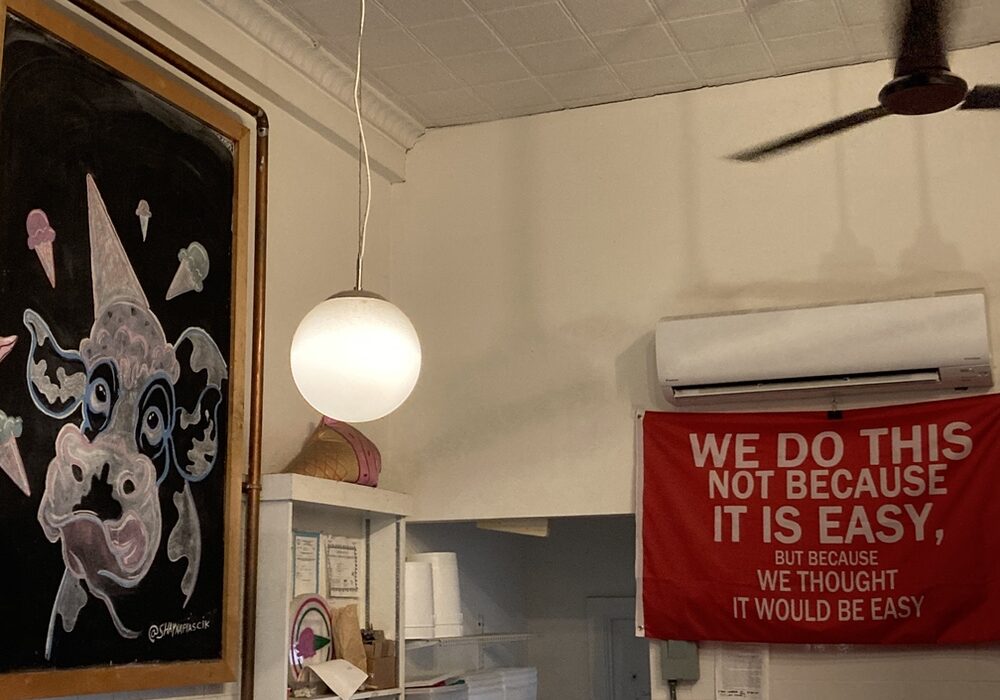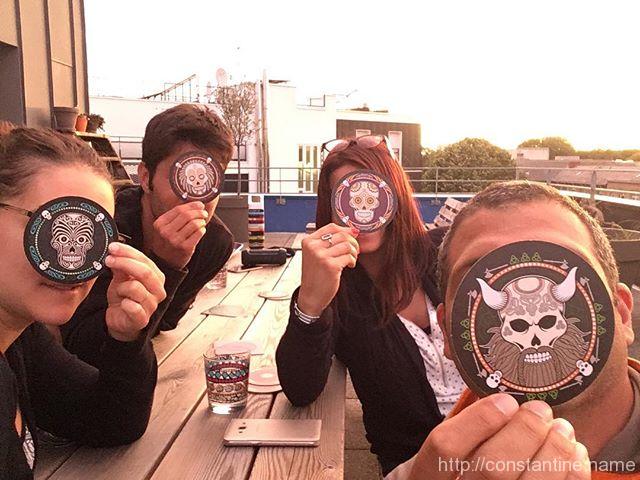I don’t often snap photos in ice cream parlors, but when I do it’s because their character is clearly on display.
ɕ

I don’t often snap photos in ice cream parlors, but when I do it’s because their character is clearly on display.
ɕ
As a filmmaker, you have a way of seeing things that is inherent in any telling of a story. You read a book, and images form in your mind, and as a director, you explain those images to the crew members. That’s what directing is, that’s what they mean when they say explaining your vision. So for me, it’s really not about any conscious desire to imprint a style. It’s simply: here’s how I see it. This is my understanding of the material. This is what affected me, here’s when I cried, we need to make sure that this moment is real, we need to make sure that your your heart is broken like I felt when I read the script. It’s about communicating exactly what you feel. And that’s the art of directing.
~ Sam Rami, from Sam Raimi – The Talks
slip:4uteie14.
I find I’m often confused by having too many options. I can get far into the weeds exploring all the possible way to do something. Instead, I truly believe that after enough time practicing some creative endeavor, it’s more important to simply follow your own feeling. Follow your own inspiration. “This is what I feel I want to do,” becomes the correct compass to follow. It’s simply: Here’s how I see it.
ɕ

Every day, the Little Box of Quotes podcast publishes a super-short recording of a quotation. For over 3 years—1,247 times and counting—I’ve said, “Hello, Craig here! Today from my little box of quotes…”
Why do all this work? It’s fun! I love sharing quotes (and in podcast form is just one way.) The total listens is north of 60,000 and some have been heard many hundreds of times. I like to imagine all the people who smiled, or went “hunh“. Each episode is only downloaded a dozen–or–so times when published. But then each episode slowly gets heard, as people randomly stumble upon them (I know not how.)
Which episodes are popular? Here are the top 10…
What do I think of that top-10 list? Listening to them—especially the number-1 “Habit” quote—makes me squirm. I can hear so much about them that I’d do differently now. Maybe that’s a good thing? And they all seem so silly… it’s just… Craig reading quotes. But there’s definitely something to this, about the resistance and making art.
How do I record them? They’re pretty raw. I say the entirety of what you hear in one pass. If I make a horrible mistake, I just do it over. There’s no editing—I simply have some basic export settings to set the overall level. The point of the entire thing (when I started) was to practice doing the thing. Talk to the mic. Don’t clean it up in post-production… rather, figure out how to not make mouth-noises, how to breath more quietly, how to sound comfortable, etc.
Where do I still struggle? Saying people’s names! (Pronunciation is difficult too, but that’s not what I mean.) The specifics of how I say the name carries a tremendous amount of information. The tiniest change has a huge affect. Do I sound incredulous that that person ever said something that clever? Do I sound overly reverential? Dismissive? And how long do I pause before saying their name? Faced with endless options, I just do my best and then ship it.
What’s my favorite part? (I have a rapid process: record, replay, save/export, schedule podcast episode. I can do one episode in a few minutes.) Sometimes, maybe 1 in 10, when I play it I get chills. Sometimes, the quote itself, combined with countless other details, makes something I just love.
ɕ
The true test of intelligence is not how much we know how to do, but how to behave when we don’t know what to do.
~ John Holt
slip:4a1226.
The essential power that confronting your mortality will give you—I call it the Sublime. Because it also opens up this idea of how amazing the world is that we live in, and how much we take for granted because we think that we’re going to live forever. It’s an incredibly important concept to me and it’s also very personal in the sense that I came this close to dying myself. I compare it to standing at the shore of some vast ocean. The fear of that dark ocean makes you turn away and retreat. I want you to get into your little boat and I want you to go into that ocean and explore it.
~ Robert Greene
slip:4a964.
There’s an Etruscan word, saeculum, that describes the span of time lived by the oldest person present, sometimes calculated to be about a hundred years. In a looser sense, the word means the expanse of time during which something is in living memory. Every event has its saeculum, and then its sunset when the last person who fought in the Spanish Civil War or the last person who saw the last passenger pigeon is gone. To us, trees seemed to offer another kind of saeculum, a longer time scale and deeper continuity, giving shelter from our ephemerality the way that a tree might offer literal shelter under its boughs.
~ Rebecca Solnit from, Rebecca Solnit on Trees and the Shape of Time – The Marginalian
slip:4utere1.
Trees are simply magical. Carl Sagan made a point in the original Cosmos series that everything uses the same basic machinery to read, and write using the same four “letters” of DNA. In a very real sense, trees are us with some different initial inputs. (Setting aside the more ephemeral, yet critical ways where we differ starkly from trees, like degree of consciousness, self-awareness, spirit, soul?) Stand next to an old enough tree and one is invariably transported to a higher level of thinking about being.
ɕ
If our goal is to help people make better choices, it helps to first create better feelings.
~ Seth Godin from, Narrative and feelings | Seth’s Blog
slip:4usena1.
Godin often makes insightful points like this one. But I often wish he’d use his enormous reach to also talk about the other part—
If our goal is to help people make better choices, it helps even more to show them how they can use their rationality. It’s an inbuilt feature of being human—sometimes I’ve argued it is the defining characteristic of being human. It is, in fact, our planetaryily-unique super power. (We have other super-powers, like compassion, which I think may not be unique to humans.)
Yes, as Godin points out, we should create better feelings for others. But how great would each of our lives be if we weren’t governed by our feelings. The goal isn’t to eliminate feelings nor emotions—that’s a dumb idea. The goal is for all the parts of who we each are, to get the appropriate due.
ɕ

I was exceptionally lucky to be born into this moment. I got to see what happened, to live as a child of acceleration. The mysteries of software caught my eye when I was a boy, and I still see it with the same wonder, even though I’m now an adult. Proudshamed, yes, but I still love it, the mess of it, the code and toolkits, down to the pixels and the processors, and up to the buses and bridges. I love the whole made world. But I can’t deny that the miracle is over, and that there is an unbelievable amount of work left for us to do.
~ Paul Ford, from Why I (Still) Love Tech: In Defense of a Difficult Industry | WIRED
slip:4uwiso2.
This hit me right in the feels. I think I’ve had a larger share of the upsides and a smaller share of the downsides than Ford. But this feels like a good overview of my formative years in tech.
Somewhere I read, “the messiness cannot go into the computer.” That summarizes what I believe is the cause of my neurosis; I’ve spent so many years now taking real-world problems, and real-world interactions with people, and factoring them into computers—and I’m left with the messy parts of the problem stuck in my mind. I’m not sure one can even understand what I’m talking about until you’ve spent 30 years, daily, working on refactoring the fuzzy of the real world into the binary of the computer world. Maybe I can reword it this way:
Computers and brains are very different. I’ve spent decades using my brain to understand computers, work with computers, and program computers.
What if that has fundamentally changed my brain?
How can I possibly pretend that, “what if,” is not utter bullshit…
That has fundamentally changed my brain.
ɕ
How can Parkour principles be adapted to improve the health, mobility, and confidence of seniors?
Sean Hannah takes us deep into curriculum development; how he researches, the importance of games and fun, and developing with specific audiences in mind. He discusses his role in designing the curriculum for the PK Move Study with Marymount University, and the specific challenges it presented. Sean shares advice on coaching and designing for adults and seniors, before unpacking his current personal curriculum and goals.
We’re going to spend a lot of time on the Single Point. …and for all the Mine Craft kids listening out there, my Fortnight players who want to do Parkour… Single Point is still your best training tool. It’s seriously overlooked in the [parkour] community because it’s hard to make money selling ninja stuff, where you’re just standing on one foot for a while.
~ Sean Hannah (20:50)
The conversation explores how Parkour can be adapted to address the unique physical and psychological challenges seniors face, focusing on fall prevention and improving overall mobility. It highlights the development of PK Silver, a Parkour program designed for older adults, and details the thought process behind designing a curriculum that makes movement both accessible and enjoyable for this age group. Games and creative scenarios are used to build strength and confidence in seniors, ultimately improving their quality of life.
The discussion also covers a study conducted with Marymount University, which examined the effectiveness of Parkour-based training for seniors. Emphasis is placed on low-impact, balance-focused exercises that encourage participants to overcome fear and improve their autonomy. The curriculum emphasizes simple but essential movements, such as getting up from the ground or navigating stairs, reimagined through the lens of Parkour. The success of the program demonstrates that the core tenets of Parkour—play, exploration, and adaptability—can have significant benefits for populations traditionally excluded from high-intensity physical disciplines.
Takeaways
Applying Parkour to seniors — Parkour can be adapted to improve balance, mobility, and confidence in seniors by focusing on simple, practical movements.
Fall prevention — Parkour’s focus on controlled landings and body awareness directly addresses the leading cause of injury and death among seniors.
Curriculum development — Designing a curriculum for seniors requires rethinking basic movement patterns, emphasizing balance, and starting from simple, low-risk activities.
Perception and fear — One of the biggest obstacles in teaching Parkour to seniors is overcoming the fear and perception that Parkour is dangerous or exclusive to younger people.
Fun and games — Reframing daily tasks as games or challenges can make movement enjoyable, reducing fear and increasing engagement.
Physical autonomy — The program emphasizes movements that directly improve seniors’ ability to navigate their environment, preserving independence and reducing fall risk.
Movement at all ages — Parkour principles apply universally, from children to seniors, reinforcing that movement exploration is valuable throughout life.
Importance of walking — Simple skills like walking are often overlooked but are essential for mobility and can be developed through Parkour-based practices.
Parkour for middle-aged adults — Programs like 401 PK show that Parkour can also address the needs of adults over 35, focusing on sustainable and low-impact movement.
Resources
PK Move — Nonprofit organization focused on bringing Parkour to seniors and special populations.
Marymount University — Partnered with PK Move to conduct a study on the effectiveness of Parkour for seniors.
Art of Retreat — An event where the PK Silver program was presented to the Parkour community.
Urban Evolution — Gym where curriculum for adults over 35 (401 PK) was developed and implemented.
American College of Sports Medicine — Hosting the presentation of the Marymount University study on Parkour for seniors.
(Written with help from Chat-GPT.)
ɕ
[15:45] I’m interested in being a whole person. I’m interested in that (Cerebral excellence) and I’m interested in – well love transcends all of it and incorporates all of it. You know, I identify as a predominantly feminine creature, as a woman. So that means my strength, where I am most joyful, where I am most powerful and effective and effectual – two different things – is when I am in this state of flow and intuition and engaged listening and sensuality.
…
[16:58] But mostly I want to receive. So my job, my job as me, as female, is to be radiant: radiant with my knowledge, radiant with my offerings, radiant in my visual brand, radiant in how I show up.
~ Danielle Laporte from, «https://becomingasuperhuman.com/gender-dynamics-technology-substances-danielle-laporte/»
ɕ

Learned a new card game as the sun set! La vie en rose… :D …but excited to start my journey home tomorrow morning!
ɕ

ɕ
6th gen prog lang: when you yell to a co-worker, “yo! email me that binary.”
ɕ
Be soft. Do not let the world make you hard. Do not let the pain make you hate. Do not let the bitterness steal your sweetness. Take pride that even though the rest of the world may disagree, you still believe the world to be a beautiful place.
~ Kurt Vonnegut
slip:4a68.